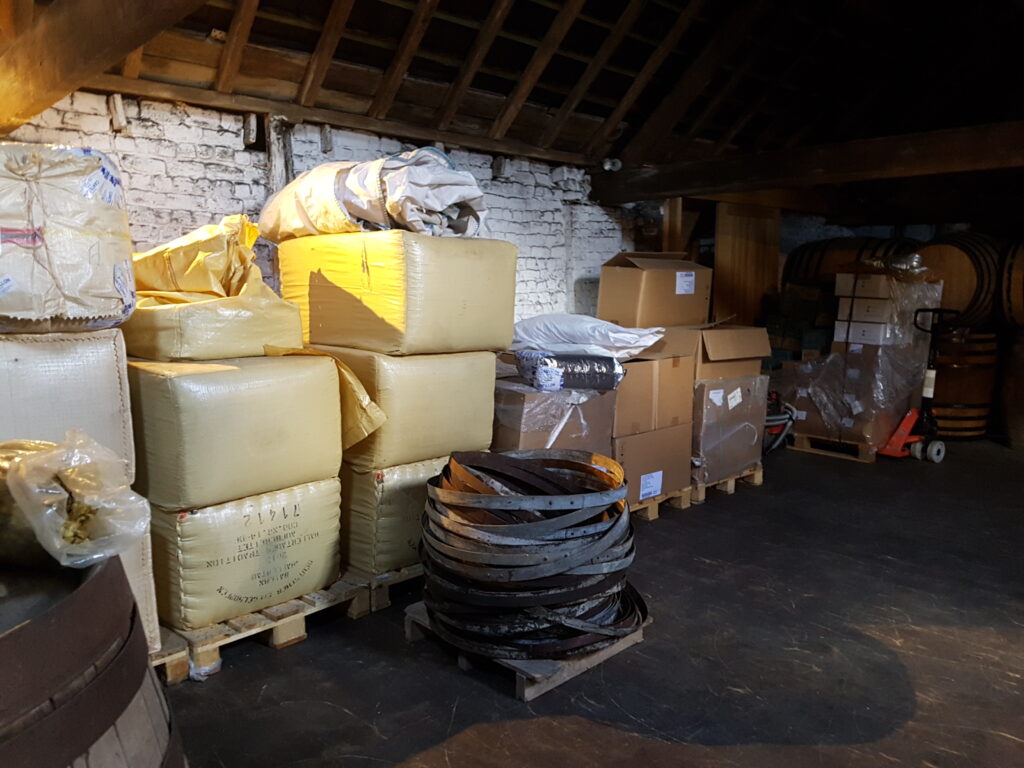A quick question for you.
Which country uses coolships in the production of an iconic beer?
The answer is Belgium. Also Germany, Czechia, England, America, Canada, and very likely others.
I’m standing in U Fleku beneath ceiling beams that carbon date to the 1350’s staring at the coolship they use for their dark lager when I’m reminded that no one knows anything. U Fleku has been brewing since 1500. Steam Beer dates from German immigration to California in the 1840’s and only really stopped being made last year. Elgood’s in the UK has coolships that they’ve repurposed for Lambic (Jonny’s got a very good video of it.)
All of these breweries pre-date Cantillon. One of them by four centuries. It was a very widespread technology for a very long time. Yet, in the texts that defined the last fifteen years of growth in interest in beer in North America, and which became resources for people who are now professionals within the industry, it doesn’t really come up.
That’s not anybody’s fault. Beer is an agricultural and technological product that is massively dependent on culture, politics, language, geography, circumstance, finance, and ultimately, whim. Not only is it difficult to parse in a momentary snapshot, but total expertise at any given moment is impossible, let alone in the long term.
You could be a Master Cicerone or a Grandmaster Judge. You could edit the Oxford Guide or work to develop a new set of professional standards. It doesn’t matter. There’s going to be stuff that you don’t know. There’s going to be received wisdom you’re parroting without questioning it because it comes from a trusted source. You haven’t been everywhere, and even if you had, you’d have missed some detail or other. The people who are really good at their jobs know this implicitly, although they might not like having it pointed out. There’s a touch of Gurdjieff about it, some third way between the sublime and the ridiculous.
If you’ve spent 1400 hours delivering lectures on the subject, this is something of which you’re acutely aware. You throw in caveats like “this may be apocryphal, but it’s commonly accepted,” before talking about Obadiah Poundage or Three Threads. It’s impossible to make it completely accurate because of limitations in time and the need to generalize. Also, these are students starting from zero, so complete academic rigour is probably unwarranted.
Eventually, it’s the limitations in time and distance that work against you. Life is busy, and expensive, and teaching doesn’t pay all the bills. You have writing to do, spreadsheets to update, data to parse, furniture to move, walking tours to lead, competitions to judge, governmental policy to excise, hops to rub, collabs to brew. The dishes aren’t going to wash themselves. Probably at some point you should do some laundry. Periodically, you might even get to live your life.
Not this weekend. This weekend I’m rebuilding my poor battered slides.
Last time I talked about the paucity of American Craft Beer in Ontario and the necessity to reimagine six hours of lectures. I’m working on that. Finalizing the choices. It won’t take long once I get down to it, but that class isn’t for a month. We start on Tuesday and I’ve made the decision to update the style slides to the 2021 BJCP standard.
At approximately eight to ten beer styles per three hour lecture, that’s 56 complex copy, paste, and edit jobs that need to happen; a couple of days work. The market attrition that’s forcing total rewrites of weeks five and six also chops away at the pillars of various lectures. Semester over semester, I’ve had to change out slides and images in the England lecture as we replaced Fuller’s ESB, Porter, and London Pride with various products, eventually settling on Clifford for the Porter and ESB. In addition to that, I’m finally going to fix a sentence that simply didn’t end on a slide about Irish Red Ale. It has bothered me for a year and a half. Trending towards order.
According to the BJCP guidelines, I couldn’t use Fuller’s ESB as a Strong Bitter anyway. There’s a complex casuistrical rendering that suggests that despite being the first one it isn’t one according to the vast majority of the American products it influenced. Whether you consider the product to be a victim of its own success or a victim of a well meaning committee square pegging a round hole, it’s a fine example of the kind of thing I’m talking about. Eventually English IPA won’t be an IPA. It practically isn’t now.
The craft beer world is not only vastly anglocentric, but disproportionately Americanized. Worse yet, with the demise or purchase of large regional breweries in the United States, the guidelines are forced to list small, local breweries in the section reserved for classic examples of each style. This requires travel, putting expertise further out of reach. Life was easier when there were fewer products. It meant everyone had a similar starting point. Ontario is actually blessed in the sense that we have to translate external signifiers from several directions, so we’re kind of used to it.
Although I don’t necessarily agree with the BJCP guidelines in certain places, I have to admit there’s a kind of Quixotic nobility to attempting to enforce informational control over a subject whose practitioners will simply not be bound. Picture Michael Jackson standing in the surf trying to hold back the sea. No, not that one.
The nice thing about having your own beer certificate is that you have total autonomy in terms of subject matter. Ultimately, your responsibility is to graduate students that know what they’re talking about and can find employment. It is a community college, after all. Frequently, I’ll help them find work, introduce them around, and give them references. They’d better be good if they’re going to reflect on me. Chances are they’re going to be around in the beer scene locally for years. I’d like them to be able to think for themselves. Not only is it the only way to survive the current informational milieu, but I’m going to need someone to talk to at festivals for years to come.
Most importantly, I want it to sing. Whenever I don’t have time to change out a slide because we’ve had to replace a beer on the fly, I can feel my soul sighing in exasperation. I know the students understand, and it allows me to talk about the market in a way that isn’t really signposted in the curriculum, but it hurts. Old code product allows you to talk about oxidation and off flavours. Sometimes even macro product is inconsistent. I think that of the 400 or so three hour sessions I’ve taught, 25% of them have gone completely to plan. Mostly they sit around 95%.
It happens when you aim high.
And that’s why you rebuild.



Your observation of the increasing decline of American beer offered for sale in the LCBO is a sad trend that I have also noted over the last 3 years. Indeed, the number of stores reducing the craft beer selection in general is on the rise. Where once the store’s beer ambassador would proudly explain the opportunities on the shelves, now many stores do not have a beer ambassador. I wonder if this situation is a result of changing consumer appetite for craft beer or a result of increased access through direct shipping from the craft breweries in Ontario. Maybe a bit of both.
Enjoyed this read. Appreciate the post!
Probably both. The craft beer segment at LCBO is very dependent on sales reps making in-store calls to build relationships and see how things are doing with their SKUs. A lot of people use digthisdata for the numerical part, but the relationships are really important. During the pandemic, you were prohibited from making in-store calls for a couple of years, which means SKUs fell out because those relationships fell apart. Also, the LCBO’s longer term employees are union, so imagine your options at the beginning of the pandemic. Plague pit or retirement? They probably shed some institutional knowledge.
Since the growth of the market was dependent on sales reps pushing and store staff listening, eliminating both halves of the equation means things get stocked on prior performance and a slide in sales generates momentum in terms of listing.